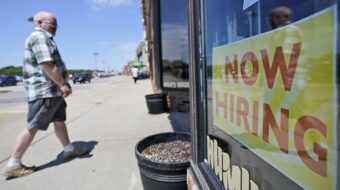It’s been said that two swallows don’t make a spring. But that didn’t stop The New York Times writer who hailed the 0.3 percent decline in the official unemployment rate last month as the “first signs” that the labor market is “healing.”
While it is true that the official unemployment rate did decline or that unemployment among African Americans fell from 11.2 percent to 10.3 percent (It was 6.2 percent in March 2000.), other indicators contradict the Times’ rosy conclusion:
• Manufacturing industries lost 11,000 in January, bringing the total for the last two months to 100,000 and continuing a trend that has seen these industries shed jobs for 52 of the last 57 months.
• The number of workers forced to work part-time because there are no available full-time jobs by 370,000.
• The labor force grew by more than 1.7 million workers over the last year, workers over age 55 accounting for seven out of every eight of these additional workers. By contrast, the largest declines in employment were among workers between ages 35 and 44 – to say nothing of the millions of young workers who never had a job to lose.
• Almost 1.9 million unemployed workers have been out of work for at least six months, triple the number three years ago. The number of “discouraged” workers – those who have given up looking for jobs – continued to increase and, by Jan. 31, stood 121,000 above the level of Jan. 31, 2002.
Unlike pundits at The New York Times, Jared Bernstein, an economist at the Economic Policy Institute (EPI) continues to speak of a “jobless economy” adding that the January numbers continue a trend that began in March 2002 with fluctuations in the month-to-month unemployment rate ranging from 5.7 to 6.0 percent.
Bernstein said one of the reasons private sector employment has contracted by 2.2 million since the recession began in March 2001 has been the weak growth in services, “a sector which typically expands fairly quickly as recoveries get underway and consumers begin to release pent-up demand.”
Bernstein compared today’s growth in service sector employment (up 1 percent in the 23 months since March 2001) with growth rates for a comparable period in six previous recessions and recoveries. Using that measure Bernstein said current growth in service sector employment “is by far” the weakest of any recession/recovery dating back to 1960. “in the absence of stronger growth in this sector,” he continued, “the economy is unlikely to turn the corner anytime soon.”
Although the millions of the unemployed and under-employed are the first victims of a crisis that sees 11 percent of the U.S. workforce under utilized, unemployment hits the living and working conditions workers who have so far managed to keep their jobs.
Persistently high unemployment has resulted in reduced wage increases for millions of workers, with only the most highly skilled among them able to keep up with increases in the cost of living.
According to EPI calculations, wages for workers in the bottom 20 percent saw their wages increase by 1.1 percent in 2002 while the cost of living increased by at least 2.2 percent.
Workers in the middle did better, with increases of 2.1 percent, but they, too, fell further behind – and these numbers fail to take into account productivity increases of nearly 5 percent last year.
The late George Meyers, long-time Labor Secretary of the Communist Party, had a very different view of the value of two swallows than does our New York Times writer. “Hell,” he would say. “Two swallows don’t even make a good drink, let alone a spring!”
The author can be reached at fgab708@aol.com

MOST POPULAR TODAY

High Court essentially bans demonstrations, freedom of assembly in Deep South

Zionist organizations leading campaign to stop ceasefire resolutions in D.C. area

UN warns that Israel is still blocking humanitarian aid to Gaza

U.S. imperialism’s ‘ironclad’ support for Israel increases fascist danger at home






Comments